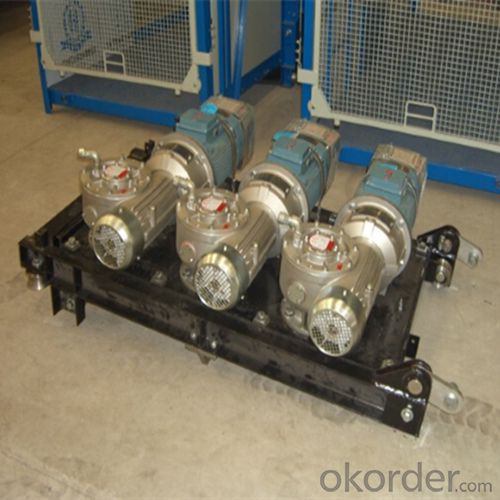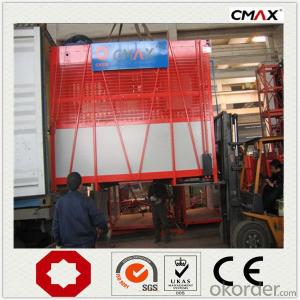Construction Hoist SCD200/200 with Counterweight
- Loading Port:
- China main port
- Payment Terms:
- TT or LC
- Min Order Qty:
- 1 unit
- Supply Capability:
- 30 unit/month
OKorder Service Pledge
OKorder Financial Service
You Might Also Like
Structure of SCD200/200 Construction Hoist Description
Payload(kg):2*2000
Lifting Speed(m/min):33
Motor Power(kw): 2*2*11
Safety Device: 2*SAJ40-1.2
Cage: Twin
Counterweight: Yes
Certification: CE,ISO
Place of Origin: China(Mainland)
Model Number: Type:SCD200/200
Packaging & Delivery of SCD200/200 Construction Hoist
Packaging Detail: Nude package
Delivery Detail: 25-30days
Main Parts of SCD200/200 Construction Hoist
● The gearing adopts imported bearing, enameled cable, and oil seal.
● The electric parts adopt products from world renowned manufactures such as Schneider, Siemens, and LG.
● The racks and pinion adopts special material and heat-treatment technique, which prolong the life of these parts.
● The surface of the structure can apply paint-spray, parkerozing baking finish or hot galvanizing processing according
to users requirements,
● The cage can be produced and decorated by aluminum molded board, punched-plate or figured aluminm board.
SCD200/200 Construction Hoist Specifiction
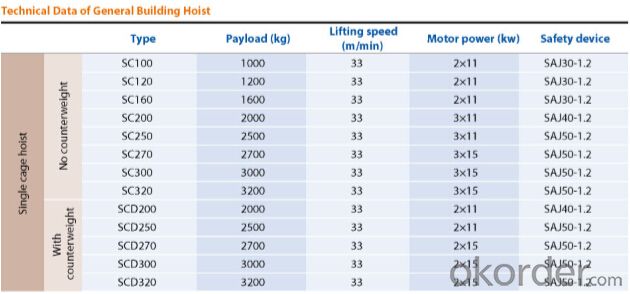
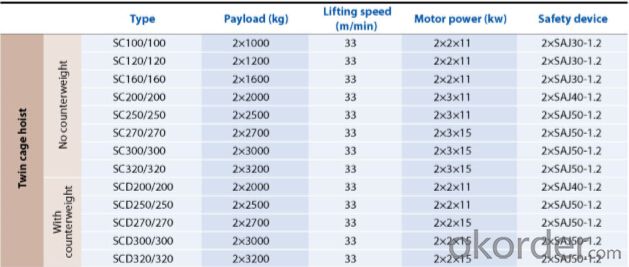
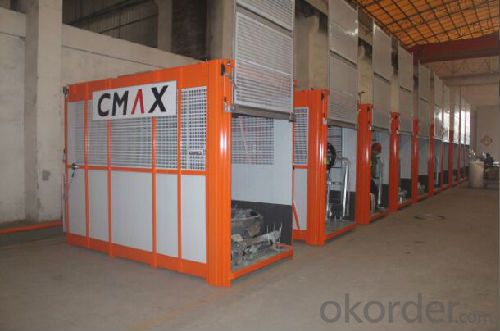

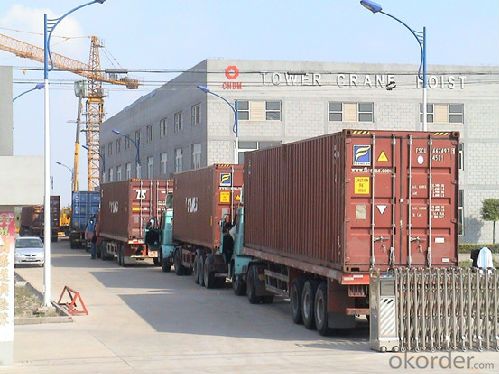
FAQ of SCD200/200 Construction Hoist
Q: What is the building hoist main purpose?
A: Building hoist equipped with double or single cabin to transport the materials and labors up and down. It's the ideal
construction equipment for vertical transportation in the field of construction.
Q: What is the main structure of building hoist?
A: The P/M construction hoist mainly contains metal structure, driving system, electrical control system, cable guide &
protection system, electrical top crane and safety device.
Q: What is the meaning of the building hoist’s code?
A: Take SC200/200 for example: “SC” stands for rack and pinion hoist, “200/200” stands for double cage and capacity
is 2 tons per cage. “SC200” stands for single cage and capacity is 2 tons.
Q: What is the dimension of the cage?
A: Normally the cage dimension is 3X1.5X2.5M (L/W/H) for 2t type hoist. Details should be checked according to our
quotation sheet. Also, the size can be customized according to the factual site condition. There are two doors (entrance
& exit doors) for each cage, It can be produced as up & down sliding or ramping model for safety and convenience.
- Q: This question asks for the method to determine the lifting capacity of a building hoist.
- <p>To calculate the weight that a building hoist can lift, you need to consider the hoist's rated capacity, which is specified by the manufacturer. This rating is based on safety factors and should not be exceeded. Check the hoist's specifications for its maximum load capacity. Ensure that the weight of the materials being lifted does not exceed this limit. Additionally, consider the hoist's mechanical condition, the strength of the cables, and the stability of the lifting points. Regular maintenance and inspection are crucial to ensure the hoist operates within its safe working load limits. Always follow the manufacturer's guidelines and safety regulations when using a building hoist.</p>
- Q: The staff on the construction platform shall not exceed the number of people
- Depending on the actual situation, different quality of platform specifications will affect the number of people manned. Hope can help you.
- Q: Is it permissible to use a building hoist for lifting a person?
- <p>No, a building hoist should not be used for lifting a person. Building hoists are designed for lifting materials and equipment, not people. Using a building hoist to lift a person is extremely dangerous and can result in severe injury or death. It violates safety regulations and is not recommended under any circumstances. Always use appropriate personnel lifting equipment or platforms designed specifically for carrying people.</p>
- Q: This question asks if building hoists are capable of moving large or heavy objects.
- <p>Yes, building hoists are specifically designed to move large and heavy objects vertically in construction settings. They are used to lift materials such as bricks, concrete, and steel beams to various levels of a building under construction. Building hoists are engineered to handle significant weight and are an essential tool for efficient material transport in tall structures where cranes may not be practical or safe for frequent use.</p>
- Q: This question inquires about the cost of a hydraulic building hoist.
- <p>The cost of a hydraulic building hoist can vary significantly depending on factors such as capacity, brand, features, and new or used condition. Prices typically range from a few thousand dollars for smaller, basic models to tens of thousands for larger, more advanced units. For a precise quote, it's best to contact manufacturers or suppliers with specific requirements, as costs can fluctuate based on the model and market conditions. It's also advisable to consider ongoing maintenance and operational costs when budgeting for a hydraulic building hoist.</p>
- Q: What are the necessary maintenance tasks and considerations for ensuring the safe and efficient operation of a building hoist?
- <p>The maintenance requirements for a building hoist include regular inspections, lubrication, and checks on all mechanical components. It is crucial to inspect the hoist's cables, pulleys, and brackets for wear and tear. The drive mechanism and safety devices should be tested for proper functioning. Lubrication of moving parts is essential to reduce friction and prevent overheating. Additionally, the electrical system should be checked for any faults or damage. It's important to keep the hoist clean and free of debris to prevent any operational issues. Following the manufacturer's guidelines for maintenance intervals and procedures is vital to ensure the hoist remains safe and efficient.</p>
- Q: This question asks for criteria to differentiate between electric and hydraulic building hoists for selection based on specific needs.
- <p>When choosing between electric and hydraulic building hoists, consider the following: 1) Power Source: Electric hoists require a reliable electricity supply while hydraulic hoists need a power source for the hydraulic pump. 2) Lifting Capacity: Electric hoists often have higher lifting capacities. 3) Speed: Electric hoists generally offer faster lifting and lowering speeds. 4) Maintenance: Hydraulic hoists may require more frequent maintenance due to fluid changes and potential leaks. 5) Noise: Electric hoists are quieter. 6) Cost: Initial costs and operating expenses should be compared. 7) Safety: Both types have safety features, but electric hoists might offer more advanced safety options. 8) Environmental Factors: Consider weather conditions; electric hoists are less affected by rain and cold. Your choice should align with the project's specific requirements, such as the weight of materials to be lifted, frequency of use, and environmental conditions.</p>
- Q: Is it possible to employ a building hoist for demolition purposes?
- <p>While a building hoist is primarily designed for construction purposes, such as lifting materials and personnel to different floors, it is not typically recommended for demolition work. Demolition requires specialized equipment that can handle the specific stresses and hazards associated with breaking down structures. Using a building hoist for demolition could be dangerous and may not comply with safety regulations. It's crucial to use equipment specifically designed for demolition tasks to ensure the safety of workers and the effectiveness of the operation.</p>
- Q: This question asks about the various mechanisms that enable lifting in building hoists, which are essential for construction projects.
- <p>Building hoists utilize several types of lifting mechanisms to efficiently move materials and personnel. The most common types include: 1. Geared Hoists, which use a system of gears to lift and lower loads. 2. Electric Chain Hoists, powered by electric motors and are suitable for heavier loads. 3. Air Hoists, which use compressed air to generate lifting force and are ideal for environments where electricity is a hazard. 4. Manual Chain Hoists, operated by hand and best for lighter loads. 5. Electric Wire Rope Hoists, which offer high lifting capacities and are controlled by electric motors. 6. Pneumatic Hoists, similar to air hoists but use pneumatic power for lifting. Each type has specific applications and safety considerations, making them suitable for different construction needs.</p>
- Q: This question asks if building hoists can be utilized for extended periods of time in construction projects.
- <p>Building hoists are generally designed for temporary use in construction projects, facilitating the movement of materials and personnel. They are not intended for long-term operations. Their design and safety features cater to the specific needs of construction phases, which are temporary by nature. For permanent installations or long-term material handling, other types of elevators or lifts are more suitable. It is crucial to adhere to the manufacturer's guidelines and local regulations regarding the use and duration of operation for building hoists to ensure safety and compliance.</p>
Send your message to us
Construction Hoist SCD200/200 with Counterweight
- Loading Port:
- China main port
- Payment Terms:
- TT or LC
- Min Order Qty:
- 1 unit
- Supply Capability:
- 30 unit/month
OKorder Service Pledge
OKorder Financial Service
Similar products
Hot products
Hot Searches
Related keywords





